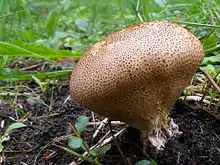Scleroderma verrucosum
Scleroderma verrucosum is a basidiomycete fungus and a member of the genus Scleroderma, or "earth balls". First described scientifically in 1791, the species has a cosmopolitan distribution, and grows in the ground in nutrient-rich, sandy soils.
| Scleroderma verrucosum | |
|---|---|
 | |
| Scientific classification | |
| Domain: | Eukaryota |
| Kingdom: | Fungi |
| Division: | Basidiomycota |
| Class: | Agaricomycetes |
| Order: | Boletales |
| Family: | Sclerodermataceae |
| Genus: | Scleroderma |
| Species: | S. verrucosum |
| Binomial name | |
| Scleroderma verrucosum | |
| Synonyms[1] | |
|
Lycoperdon verrucosum Bull. (1791) | |
Taxonomy
The species was first described by Pierre Bulliard in 1791 as Lycoperdon verrucosum.[2] Christian Hendrik Persoon transferred it to the genus Scleroderma in 1801.[1] The specific epithet verrucosum means "warted".[3]
Description
The fruit body is roughly spherical with a somewhat flattened top, and has a thick, stem-like base; it attains a diameter of 2–7 cm (3⁄4–2+3⁄4 in). Its color is ochre or dingy brown, and the surface is covered with scaly warts that eventually slough off to leave a relatively smooth surface.[4] The thin flesh underneath the peridium stains pink to red when the fruit body is cut open.[5] The peridium (outer skin) is thin and fragile when dry, and cracks irregularly to form a large opening. The internal spore-bearing tissue, the gleba, is initially white, but becomes light brown and powdery after the spores mature. The spores are spherical, and covered with minute warts or spines, and measure about 12 μm in diameter.[4]
The fruit bodies are edible when the gleba is still firm and white.[4] On the other hand, S. verrucosum appears to cause poisoning symptoms similar to Scleroderma citrinum at least in some people, so it cannot be recommended for consumption.[6][7]
Habitat and distribution
Sclerodermas are ectomycorrhizal.[8] The fruit bodies of Scleroderma verrucosum grow in the soil in nutrient-rich, sandy soil, often in deciduous forests. The species has been found in Africa,[9] Asia (China[10] and India[11]), Australia, Europe, North America[4] (including Hawaii),[5] and South America.[12]
The species was featured on a Paraguayan postage stamp in 1985.[13]
See also
References
- "Scleroderma verrucosum (Bull.) Pers. 1801". MycoBank. International Mycological Association. Retrieved 2012-10-01.
- Bulliard P. (1791). Histoire des champignons de la France. I (in French). Paris, France. p. 154, t. 24.
- Arora D. (1986). Mushrooms Demystified: A Comprehensive Guide to the Fleshy Fungi. Berkeley, California: Ten Speed Press. p. 912. ISBN 0-89815-169-4.
- Dickinson C; Lucas J. (1982). VNR Color Dictionary of Mushrooms. Van Nostrand Reinhold. pp. 32–3. ISBN 978-0442219987.
- Hemmes DE; Desjardin D. (2002). Mushrooms of Hawai'i: An Identification Guide. Berkeley, California: Ten Speed Press. p. 119. ISBN 1580083390.
- Gemeiner Kartoffelbovist. In: Pilzdatenbank des Giftnotrufs München. Retrieved, 13 January 2014.
- Rosemarie Kießling: Eine Vergiftung mit Scleroderma Verrucosum (Bull.) Pers. 1801. Website der Deutschen Gesellschaft für Mykologie. Retrieved, 13 January 2014.
- Trudell S.; Ammirati J. (2009). Mushrooms of the Pacific Northwest: Timber Press Field Guide (Timber Press Field Guides). Portland, Oregon: Timber Press. p. 271. ISBN 978-0-88192-935-5.
- Sanon KB; Bâ AM; Dexheimer J. (1997). "Mycorrhizal status of some fungi fruiting beneath indigenous trees in Burkina Faso". Forest Ecology and Management. 97 (1): 61–9. doi:10.1016/S0378-1127(97)00089-3.
- Jian-Zong L. (2003). "Studies of Scleroderma from China". Hunan Shifan Daxue Ziran Kexue Xuebao (in Chinese). 26 (4): 60–4. ISSN 1000-2537.
- De AB; Debasmita R. (2007). "Scleroderma verrucosum (Bull.) Pers. – an addition to the fungi of West Bengal, (India)". Journal of Natural History (India). 3 (1): 31–3. ISSN 0973-6166.
- Trierveiler-Pereira L; Baseia G. (2009). "A checklist of the Brazilian gasteroid fungi (Basidiomycota)". Mycotaxon. 108: 441–4. doi:10.5248/108.441.
- Moss MO. (1998). "Gasteroid Basidiomycetes on postage stamps". Mycologist. 12 (3): 104–6. doi:10.1016/S0269-915X(98)80005-0.